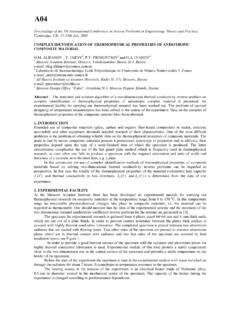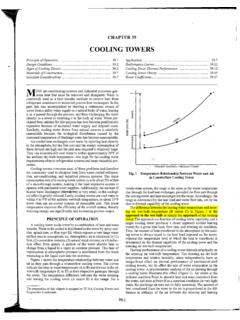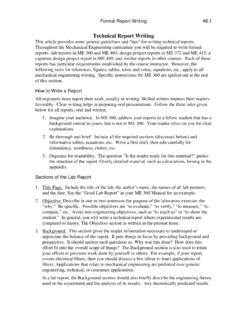Transcription of INTRODUCTION TO FINITE ELEMENT METHOD - me.ua.edu
1 INTRODUCTION to FINITE ELEMENT METHOD INTRODUCTION TO FINITE ELEMENT METHOD 1 THE NATURE OF APPROXIMATION In order to be a solution to a partial differential equation, the solution must satisfy: the differential equation the boundary conditions the initial conditions (for an unsteady or nonstationary problem) Consider the steady one-dimensional form of the continuity and energy conservation equations with constant properties: ()0= udxd ( ) () = dxdTdxdckuTdxdp ( ) subject to the boundary conditions 00)0(uu = ( ) 0)0(TT= ( ) LTLT=)( ( )
2 The exact solution to these equations is 00uconstu == ( ) 1/exp1/exp)(00 = ppLckuLLxckuLTTTxT ( ) Equations ( ) and ( ) satisfy the governing partial differential equations (Eqs. ( )-( )) and the boundary conditions (Eqs. ( )-( )) and thus constitute the solution to the problem posed. Suppose we wish to approximate the solution to the equation ( ), rather than obtain its exact solution. One possible METHOD would be to use the METHOD of weighted residuals (MWR) to obtain an approximate analytical expression for the variation of T(x) over the domain 0 x L.
3 This METHOD will be explained later in detail, but we make an example of its application here as an INTRODUCTION . We begin by assuming a functional form of the solution. A simple polynomial expression, a quadratic, will be used. INTRODUCTION to FINITE ELEMENT METHOD 2 ( ) 221020)(~xaxaaxaxTiii++== =To be a solution , the expression must satisfy the boundary conditions ( )-( ). We take for this example L=1, T0=1, and TL=0. Applying these boundary conditions to the expression ( ), we find that )1(1210aaa+ == ( ) So the polynomial ( ) is reduced to an expression with only one unknown constant, a2: )(1)(~22xxaxxT + = ( ) To evaluate the remaining constant, we use one of a class of methods called the METHOD of weighted residuals (MWR).
4 If we substitute the approximate expression ( ) for Tinto the differential equation ( ), the equation will not, in general, be satisfied. In other words, some residual will exist which varies over the domain. )(~x 0~~/)(22 =dxTddxTdckuxRp ( ) The MWR minimizes the error in the approximation by forcing this residual to zero in some \ average, weighted sense. ( ) ==LinidxxRW0,..2,1 0)(Note that the number of weight functions Wi, and hence the number of weighted residual expressions, must equal the number of unknown constants in the residual expression. One of the subclasses of the MWR is the collocation METHOD , where the weight functions are simply the Dirac delta functions, )(ixx.
5 The weighted integration then simply forces the residual to zero at a fixed number of discrete points within the domain. For the current example, we need one weighted residual statement to evaluate the remaining single constant in the approximation. We choose to collocate the residual at the midpoint of the domain, xi= Hence, 0~~/)(22= =iixxpidxTddxTdckuxR ( ) Now, by computing the required derivatives directly from the equation ( ), we find )12(1~2 + =xadxTd ( ) INTRODUCTION to FINITE ELEMENT METHOD 3 2222~adxTd= ( ) Substituting these expressions into the residual expression ( ) yields [222)12(1/)(axackuxRp + ] = ( )
6 Now, we collocate this residual at the midpoint of the domain 22)1(/0) (ackuRp == 2Pe/22 = =pckua ()xxxxT =22Pe1)(~ ( ) Here Pe is the Peclet number, Pe = uLcp/k. The Peclet number represents the relative strength of the convective flux ( ucp) to that of the diffusive flux (k/L), and may be positive or negative according to the sign of u. The graph on the following page illustrates the behavior of the exact solution, given by Equation ( ), and the approximation, given by Equation ( ) for the range -5 Pe +5. Note that the approximation does well for low Pe, but errs grossly for Pe = 5. What can be done to improve the approximation?
7 One obvious suggestion would be to increase the order of the approximating polynomial. Another, less obvious, notion is to decrease the extent of the domain over which the polynomial approximates T(x). In other words, break the overall domain into smaller pieces, and assume an approximating function for T over each sub-domain. This facilitates the use of lower, not higher, order approximations over the sub-regions. This is the basis for the FINITE ELEMENT METHOD (FEM). INTRODUCTION to FINITE ELEMENT METHOD 4 = - 5 Exa c tPe = - 5 MW R Pe = - 1 Exa c tPe = - 1 MW R Pe = ExactPe = MWRPe = +1 Ex ac tPe = +1 MWR Pe = +5 Ex ac tPe = +5 MWR Figure 1. Quadratic MWR solution (Eq. ) compared with exact solution (Eq.)
8 An Introductory Example AN INTRODUCTORY EXAMPLE 5 We would like to get an overview of the steps required for application of the FEM to a new problem. These steps are: 1. Discretize the domain. 2. Select the ELEMENT interpolation functions. 3. Determine the ELEMENT equations. 4. Assemble the ELEMENT equations into the system equations. 5. Apply the boundary conditions to the system equations. 6. Solve the system. 7. Perform any supplemental calculations (post processing). We will use the one-dimensional example of the previous section as a vehicle for illustrating these steps. This example is intended to give an overview only, as many of the steps must be explained in detail later. Step 1. Discretize the domain. The domain is one-dimensional, having an extent from 0 to L.
9 We will divide the domain into a series of n segments of uniform length. Each segment has two nodes, one at either end, hence there will n+1 nodes in the system. The nodes serve as the location points for calculation of the field variable T. Step 2. Select the ELEMENT interpolation functions. Conceptually, this is a central step in the FEM. There are some requirements which must be followed in selection of these interpolation functions to assure convergence of the METHOD , and these will be stated later. Generally, the approximations are taken from the family of polynomials, and the lowest order polynomial which satisfies the requirements for convergence are usually chosen. In this case, a linear variation of T(x) over each ELEMENT is assumed: ( ) []{}TN= =2121)()()(TTxNxNxTwhere ()()()() )( )(12121221xxxxxNxxxxxN = = ( ) The role of the interpolation row matrix [N] is to operate on the column vector of nodal temperatures {T} to yield the value of T(x) for x1 x x2.
10 Note that the interpolation functions embody all of the spatial dependence of the dependent variable. Step 3. Determine the ELEMENT equations. The approach to be used exclusively in this course is a MWR approach. In this particular example, and in much of what follows, a Galerkin MWR approach is used. The major steps to be taken to derive the ELEMENT equations are: An Introductory Example 6 1. Multiply each term in the governing equation by a weight function, Wi. 2. Substitute the approximation for the field variable (Equation ( )} into the resulting equation. 3. Integrate the equation (either formally or numerically) to obtain the ELEMENT matrix equations. Use integration by parts (Green's theorem) on the highest order derivative in the equation.)



















